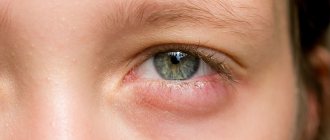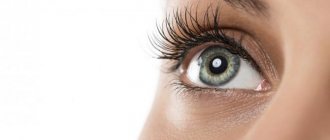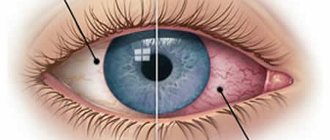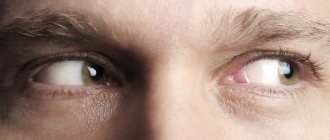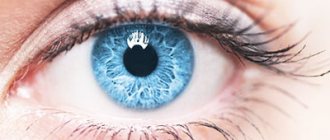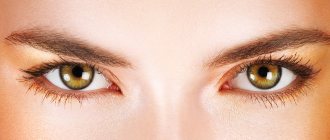Symptoms: blurred vision, temporary loss of visual acuity, sand in the eyes, tension in the eyes, tired eyes, dizziness, headache, heaviness in the head, objects blur, I can’t focus on an object, everything floats in front of the eyes, feeling of sand in the eyes, intraocular pressure.
Our patients often experience one or another problem in the eye area or vision problems. At the same time, a person’s vision can be absolutely normal, but in certain situations associated with intellectual or psycho-emotional stress, it drops sharply: a person cannot focus his gaze on an object in the distance or near, a “veil appears before the eyes”, objects blur, there is no “sharpness” "vision, which can only be achieved with great effort.
Why does it put pressure on the eye?
In a situation where the eyes hurt as if they were pressing, it is necessary to study the regularity of this manifestation and the circumstances of its occurrence. For isolated attacks in people working at a computer or with papers, there is no need to worry too much. It is necessary to contact a specialist if the patient develops additional symptoms. A condition when there is constant pressure on the eyes is considered a dangerous signal, so this most often indicates various diseases.
Migraine
With a pathology such as migraine, pain localizes to one side of the head. In addition, there is a pulsation in the temple, which spreads to the ear and organs of vision. If your eyes are closed, colored circles are formed, which are complemented by flashes. In addition, there is pronounced pulsation in the eyelid area.
Overwork
Working at a computer for too long and reading small print texts increases the likelihood of eye discomfort. In addition, the cause of severe pain can be any activity that requires increased attention and strong visual strain.
With severe overwork, a person suffers from pain in the organ of vision, a sensation of cutting and burning. It feels as if sand has been poured into the eyes, and there is a disturbing feeling of pressure and heaviness.
Glaucoma
A pathology such as glaucoma, caused by an increase in pressure inside the organ of vision, does not always provoke pain. Usually there is a dull or aching pain, which is complemented by various visual changes. Fogging of the cornea, the appearance of rainbow circles and photophobia are observed.
During an acute attack of glaucoma, the patient experiences sudden pain in the organ of vision, which radiates to the temples, the back of the head and sometimes along the trigeminal nerve. Attacks of nausea and dizziness, as well as significant changes in the eyes, may occur. When examining the patient's face, it becomes noticeable that the cornea and eyelids swell greatly, and the pupil dilates significantly.
Increase in pressure
The situation with pain from inside the eyes may indicate surges in intracranial pressure. The cause of the pathological condition lies in a concussion, stroke and impaired outflow of cerebrospinal fluid. In addition, a rapid increase in the size of a cyst or malignant neoplasm localized in the skull can cause pain.
The patient complains not only of pressure, but also of increasing pain, pain and pulsation behind the organ of vision. When coughing, blowing your nose and other sudden movements, an even greater increase in pain is noted. In addition, symptoms such as nausea, spots before the eyes, hallucinations and increased drowsiness may appear.
In some cases, pressure from inside the eyelids and the appearance of a feeling of fullness inside the organ of vision indicate surges in intraocular pressure. The patient experiences severe redness of the sclera and a feeling of heaviness in the eyelids.
If the increase in pressure inside the eyes is chronic, then there is a high probability of degeneration of the optic nerve and the appearance of glaucoma. With this pathological condition, the patient experiences a gradual narrowing of the field of vision and, in the worst case scenario, the patient may become completely blind.
Other reasons
Experts identify some reasons that cause increased pressure in the eye and pain:
- Increased psycho-emotional stress. In this condition, any increased stress can cause severe pain in the forehead and eyes.
- Osteochondrosis of the neck. The cause of damage to the organ of vision is frequent headaches and curvature of the spine.
- Various visual impairments. Various infections inside the organ of vision, inflammatory processes, barley and injuries to the corneal layer of the eye can provoke an unpleasant symptom.
- Problems with blood supply to the brain. This condition causes headaches, which can result in a stroke.
- Injuries and damage to the skull. Pressure in the eye in this pathological condition can be accompanied by weakness, nausea, double vision, and a constant desire to sleep.
- Changes in hormone levels in the female body. Most often, expectant mothers experience a feeling of pressure in the eye during pregnancy.
Causes of pain in the eyes
There are many reasons that can cause pain in the eyes:
A process of an inflammatory nature. Such diseases include conjunctivitis and keratitis. In any case, they are accompanied by redness of the eyelids, the release of tears and a feeling of pain in the eyes. Purulent discharge may or may not be present. In some cases, there is a runny nose and increased body temperature. Bacteria, fungi, viruses, and allergens can provoke the inflammatory process.
Blepharitis and uevitis are both diseases affecting the eyelids. Often accompanying symptoms are fear of light and the production of tears.
Demodecosis. This disease affects the eyelash sacs. Its causative agents are microscopic mites.
Poor quality or unsuitable contact lenses.
Excessive eye strain.
Trinitarian neuralgia. This pathology is accompanied by pain not only in the eye area, but also in the entire face, and even in the oral cavity.
Astigmatism is another cause of pain in the eyes.
Low-quality cosmetics can provoke a feeling of pain and stinging in the eyes.
Eye injury, which includes a fall, blow, or contact with any foreign object.
Burns of various origins. This includes burns of thermal origin, such as: from steam or hot water, as well as chemical origin, for example, from contact with the mucous membrane of the eye with household chemicals or reagents.
Pathologies of the thyroid gland and diseases associated with it can cause pain in the eyeballs.
Ingress of tobacco smoke.
Increased intraocular pressure caused by problems in neuralgia or having an ophthalmological origin.
Disorders of the sebaceous glands.
Corneal ulcers, although rare, are still a common occurrence.
In what cases should you consult a doctor?
Most often, eye pain can be dealt with at home on your own. However, in some situations the patient requires urgent assistance from a specialist. You should consult a doctor as soon as possible if:
- pain does not disappear after taking medications with an analgesic effect and performing various procedures aimed at alleviating the condition;
- pain syndrome torments the patient constantly, regardless of the duration of treatment;
- pressure in the eyes is complemented by severe discomfort;
- pressure and pain in the eyes are combined with temperature fluctuations.
With pain in the eyes, nausea and severe discomfort in any part of the skull, dangerous pathologies can be suspected. Often this sign indicates meningitis, cancer or stroke.
Symptoms of pain
Most often, pain in the eyes does not appear on its own; it is accompanied by a number of symptoms, which include the following:
- Redness of the mucous membrane of the eye.
- Dilatation of blood vessels inside the eyeball and on the lower and upper eyelids.
- Tearing.
- Photophobia.
- A feeling of discomfort in the eye area.
- Itching.
- Sometimes there is discharge of pus from the lacrimal canals.
- Sometimes peeling may occur.
- Swelling of the eyelids.
- Sometimes redness affects the iris of the eye.
- Painful sensations.
Diagnostics
It is necessary to find out why there is pressure on the eyes from an ophthalmologist. Using a special device, intraocular pressure is measured and the result is evaluated. In addition, an ophthalmological examination is carried out aimed at studying the condition of the optic nerve.
To confirm the diagnosis, the following types of studies may be prescribed:
- MRI. Using this procedure, it is possible to determine which pathologies caused the unpleasant symptom. MRI helps identify strokes, cystic formations, tumors and hydrocephalus.
- Ultrasound. This diagnostic method determines the presence or absence of vascular damage, thrombosis and the speed of blood flow.
- CT. The procedure determines the presence of an inflammatory process affecting the bone structure of the head. In addition, CT scans can detect the presence of pathologies such as sinusitis and frontal sinusitis.
If indications are present, the ophthalmologist may refer the patient for consultation to other specialists.
Methods for treating pain in the eyes
You should not ignore such a symptom as pain in the eyes, even if it causes minor discomfort. Using eye drops incorrectly can ultimately lead to serious vision problems. Therefore, if there is pain in the eyes, you should first consult an ophthalmologist. Depending on the cause of the discomfort, the doctor will prescribe appropriate treatment.
Most often, examination with an ophthalmoscope is sufficient to determine pathology. In some more complex cases, a sample or smear from the surface of the eye, or a scraping from the eyelids, is required. After which treatment is prescribed
Tetracycline ointment. A product such as tetracycline ointment has a wide spectrum of action and its use is indicated for corneal burns, conjunctivitis, minor household injuries, as well as diseases caused by bacterial microflora that are sensitive to the components of the ointment. The doctor decides how long the treatment will last. This remedy can be called universal, since it has no contraindications or side effects.
Levomycetin is a broad-spectrum antibiotic and is capable of destroying pathogenic bacteria. Used to treat bacterial conjunctivitis.
If pain in the eyes is caused by a symptom of dry eye, then the patient is prescribed special drops that replace natural tears. They are instilled into the conjunctival sac several times a day. It is important to consume enough fluid.
Such means include:
Moisturizing gels, for example, Korneregel, can also be prescribed. If it is necessary to restore processes at the cellular level, then it is advisable to use Actovegin eye jelly.
An effective remedy for viral infections of the eyeball, as well as for the treatment and prevention of dry eye syndrome, is the drug Ophthalmoferon. It can be used in both adult patients and children and has no side effects.
If it is determined that pain in the eyes is caused by wearing lenses, then you should be more careful in choosing them. Sometimes, when dry eye syndrome develops, a person has to completely abandon them and improve their own vision with the help of glasses. This recommendation should not be neglected, since wearing unsuitable lenses will only worsen eye problems, even leading to sudden loss of vision. An alternative option is to use lenses made from modern materials.
There are conditions that require a patient with pain in the eyes to be in an ophthalmology hospital, for example, with serious injuries and burns of the eyes, with a corneal ulcer. In such cases, an integrated approach and, sometimes, surgery are required. This is a complex procedure that requires surgical removal of the damaged area and replacing it with a new one taken from an eye donor. Most often, it is in this way that a person’s vision can be preserved.
In order to protect your eyes as much as possible from all kinds of problems, it is necessary to observe certain precautions and preventive measures, among the main ones are:
Compliance with basic rules of personal hygiene, timely washing of hands.
Visiting an ophthalmologist to have your vision checked. As a preventive measure, it will be enough to see a doctor once a year.
Removing all cosmetics from the face and eyes before resting at night.
It is necessary to give your eyes rest. This is especially true when there is excessive eye strain. If possible, you should do eye exercises every hour.
You should protect your eyes from bright sunlight by wearing a hat and glasses with dark lenses. The same rule applies not only to sunlight, but also to artificial light. You should not look at incandescent lamps, headlights at night, the operation of a welding machine, etc.
You need to blink as often as possible.
It is important to wean children from an early age from touching, and even more so from rubbing their eyes with their hands.
Take vitamins. Vitamins A and B2 are especially beneficial for vision.
Night rest should be complete and consist of at least seven hours.
If you feel pain in your eyes after working at the computer, it would be advisable to use drops that replace natural tears.
If you experience an unexplained feeling of discomfort, decreased vision, or pain in the eyes, it is important to see an ophthalmologist as soon as possible.
How to deal with the problem
After determining the cause of this condition, when there is pressure from inside the eye, a specific treatment is selected.
Drugs
Drug therapy includes taking painkillers such as Analgin and Pentalgin. The condition can be alleviated with the help of non-steroidal drugs with an anti-inflammatory effect, among which Diclofenac and Ibuprofen are considered the most effective. To improve the removal of fluid from the body, it is possible to prescribe drugs such as Furosemide and Diacarb.
Patients whose cause of pain in the eyes is a bacterial infection are prescribed antibacterial drugs. To treat the eyes, it is recommended to use Erythromycin ointment, and oral medications in tablets, for example, Cephalexin and Amoxicillin.
When pain in the eyes occurs as a result of stress or nervous tension, various antidepressants, tranquilizers and sedatives can be prescribed. For increased intraocular pressure, drops such as Azopt, Travatn, Bitoptik and Pilocarpine are usually prescribed.
Exercise for the eyes
You can relieve pain caused by fatigue with the following exercises:
- you need to look left and right, up and down;
- move your eyeballs clockwise and back;
- draw a square in the air clockwise and back;
- Draw several figure eights in the air in a horizontal and vertical position.
You need to do the exercises up to 10 times during the day, adhering to the specified sequence.
Non-traditional treatment methods help alleviate the patient's condition, but they are unable to completely cure the disease. At home, it is recommended to wash your eyes with chamomile or aloe decoctions. To do this, moisten a cotton pad in the prepared liquid and wipe your eyes with it so that the product is slightly squeezed onto the mucous membrane.
It is allowed to take decoctions of mint or lemon balm, which will relieve unpleasant sensations inside the organ of vision. Clover infusion helps to cope with discomfort due to pressure surges inside the eye.
How to help your eyes?
First aid can be provided to yourself, depending on the cause of the discomfort.
— Artificial tear preparations, as well as products with a reparative (restorative) effect based on dexpanthenol, will help relieve the discomfort of “dry eye syndrome.”
— Eye discomfort that occurs when wearing contact lenses may be a sign of damage to the ocular surface, which must be healed at the initial stages and prevent inflammation and infection. As a healing agent, ophthalmologists often recommend Korneregel, a drug with dexpanthenol, which restores damaged eye tissue, has an anti-inflammatory effect, and also moisturizes, eliminating discomfort.
- in case of infectious and inflammatory diseases of the eyes, the signs of which are a feeling of sand in the eyes, pain, redness, purulent discharge from the eyes, you must immediately contact an ophthalmologist, he will prescribe the appropriate treatment.
— If you have nearsightedness, farsightedness, or astigmatism, you need to contact an ophthalmologist and choose the right glasses or contact lenses.
It is important to promptly pay attention to even slight or irregular eye discomfort - otherwise you may not notice how quickly a dangerous disease begins to progress.
Contact lenses and home theater: are they compatible? The average Russian's weekdays are usually overloaded with work, household chores and other constant worries. Due to high social activity on weekdays, most people prefer to spend weekends at home, taking advantage of the rare opportunity to be close to loved ones and relax in front of the screen, enjoying their favorite action movie or melodrama.
